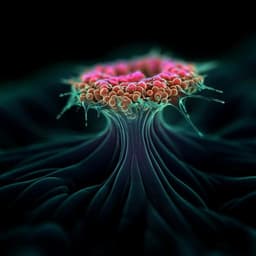
Chemistry
Dispersed surface Ru ensembles on MgO(111) for catalytic ammonia decomposition
H. Fang, S. Wu, et al.
This groundbreaking research from authors at the University of Oxford and other institutions explores the remarkable catalytic activity of atomically dispersed Ru atoms on MgO(111) for ammonia decomposition, achieving a record-breaking decomposition rate by leveraging strong metal-support interactions. This study challenges existing beliefs by showing that more Ru does not always mean better performance.
Playback language: English
Introduction
Ammonia (NH3) is gaining significant attention as a promising energy vector for hydrogen storage, transport, and utilization, particularly in the context of renewable energy integration. Efficient and cost-effective catalysts for ammonia decomposition are crucial for realizing the full potential of ammonia as a hydrogen carrier. While ammonia possesses a high energy density (4.25 kWh/L) and can be easily liquefied, the development of efficient catalysts and a thorough understanding of the underlying reaction mechanisms remain significant challenges. Many transition metals, including nickel (Ni) and ruthenium (Ru), exhibit catalytic activity for ammonia decomposition, but Ru stands out due to its superior performance at lower temperatures. However, the structure sensitivity of Ru-based catalysts for ammonia decomposition is well documented, with activity being highly dependent on the Ru particle size, shape, and support material. Traditional Ru-based catalysts often suffer from hydrogen poisoning, hindering their efficiency. The prevalent view focuses on B5 sites (Ru clusters) as the primary active sites, but this approach often leads to low atom economy due to the high cost of Ru. Homogeneous catalysis offers an alternative perspective, highlighting the importance of bimetallic or multinuclear redox sites for N2 coordination and activation. This study aims to explore a novel approach by investigating the catalytic performance of atomically dispersed Ru ensembles on the polar MgO(111) facet, a high-energy facet with alternating layers of O²⁻ and Mg²⁺. The unique properties of this support and the controlled dispersion of Ru are expected to provide insights into achieving higher activity and atom economy in ammonia decomposition.
Literature Review
Extensive research has been dedicated to developing efficient catalysts for ammonia decomposition, focusing primarily on transition metals. Studies on Ni-based catalysts have shown promising results at relatively high temperatures, driven by their low cost. However, Ruthenium (Ru) has emerged as a superior catalyst for low-temperature ammonia decomposition due to its significantly higher activity. Previous work has systematically explored various Ru-based catalysts with different supports, structures, and particle sizes, revealing a strong structure sensitivity. This sensitivity is often attributed to the presence of B5 sites in Ru clusters, which are considered crucial for N2 activation via a dissociative pathway. Researchers have devoted considerable effort to optimizing the number of B5 sites through particle size and shape control. However, the formation of Ru nanoparticles reduces the atomic economy and increases the cost, limiting the scalability of these catalysts. Furthermore, hydrogen poisoning remains a major concern for traditional Ru-based catalysts, as hydrogen adsorption blocks active sites and hinders the chemisorption of nitrogen species. Homogeneous catalysis provides a valuable contrast, revealing distinct active sites for reversible N2/H2 activation. Bimetallic or multinuclear complexes with ligand-stabilized redox sites can effectively coordinate N2 through various intermediate species, offering a different perspective on active site design for ammonia chemistry. This work seeks to bridge the gap between heterogeneous and homogeneous catalysis by investigating the activity of surface-dispersed Ru ensembles on MgO(111), comparing their performance to Ru clusters and considering the hydrogen removal ability at the support interface.
Methodology
The study involved the synthesis of MgO nanosheets with preferential exposure of (111), (110), and (100) facets. MgO(111) was prepared using a hydrothermal method with benzoic acid as a surfactant. MgO(110) was synthesized by reconstructing commercial MgO through a boiling and vacuum calcination process. MgO(100) was prepared via the thermal decomposition of Mg(NO3)2. MgO nanocubes were also synthesized and then cleaved to create various ratios of (100), (110), and (111) facets. Ru-supported MgO catalysts were prepared using Ru3(CO)12 decomposition onto the MgO supports. The catalytic performance of the Ru/MgO catalysts was evaluated using a continuous flow fixed-bed reactor, measuring ammonia conversion and hydrogen production at different temperatures and weight hourly space velocities (WHSV). Kinetic studies were performed to determine reaction orders with respect to NH3 and H2. A range of characterization techniques were employed, including X-ray diffraction (XRD), scanning transmission electron microscopy (STEM), X-ray photoelectron spectroscopy (XPS), X-ray absorption fine structure spectroscopy (EXAFS), temperature-programmed desorption (TPD), temperature-programmed surface reaction (TPSR), in-situ diffuse reflectance infrared Fourier transform spectroscopy (DRIFTS), and ambient pressure XPS (AP-XPS). Density functional theory (DFT) calculations were used to model the interactions between Ru and MgO supports, explore reaction pathways, and analyze the electronic structure of the catalysts.
Key Findings
The researchers demonstrated that atomically dispersed Ru on the polar MgO(111) facet exhibits superior catalytic activity for ammonia decomposition compared to Ru supported on other MgO facets or to Ru nanoparticles. The Ru/MgO(111) catalyst achieved a turnover frequency (TOF) of 3.43 s⁻¹ at 400 °C and 4.91 s⁻¹ at 450 °C, surpassing previously reported values. The superior performance was attributed to strong metal-support interactions, facilitating efficient hydrogen removal and preventing hydrogen poisoning. Characterization techniques revealed that Ru on MgO(111) exists as atomically dispersed species or small ensembles rather than nanoparticles or clusters. XPS analysis indicated a Ru²⁺ oxidation state, while EXAFS confirmed 3-oxygen coordination with no Ru-Ru bonds. STEM imaging visualized atomically dispersed Ru atoms, as well as small pairs and trimers of Ru atoms. Kinetic studies showed a significantly lower negative reaction order for hydrogen on Ru/MgO(111) compared to Ru on other MgO facets, indicating efficient hydrogen removal. The apparent activation energy (Ea) for ammonia decomposition was also lower on Ru/MgO(111) (71.3 kJ mol⁻¹), suggesting a faster reaction rate. In-situ DRIFTS experiments demonstrated the formation of surface OH species during ammonia decomposition, confirming the spillover of hydrogen from Ru to the MgO(111) surface. AP-XPS revealed reversible changes in Ru oxidation state and surface OH species upon switching between NH3 and Ar atmospheres. DFT calculations supported the experimental findings, showing that stepwise dehydrogenation of ammonia is energetically favorable on the 2x Ru/MgO(111) model, with a lower energy barrier for N-N recombination on MgO(111) compared to other facets. The DFT studies highlight the synergistic effect of neighboring Ru atoms in facilitating N-N bond formation. The loading effect of Ru was investigated, showing a double volcano-type trend in TOF, with optimal activity at moderate surface concentrations before the formation of larger Ru nanoparticles with B5-type sites. This suggests the superiority of atomically dispersed Ru ensembles with close interconnections on MgO(111) compared to classical stepped B5 sites on Ru nanoparticles.
Discussion
The findings of this study provide compelling evidence for the exceptional catalytic activity of atomically dispersed Ru ensembles on the polar MgO(111) surface for ammonia decomposition. The superior performance compared to Ru nanoparticles challenges the traditional focus on B5 sites as the primary active sites for this reaction. The strong metal-support interaction on the MgO(111) surface plays a critical role in facilitating efficient hydrogen removal, preventing hydrogen poisoning, and promoting N-N bond formation. The observed synergistic effect of neighboring Ru atoms in close proximity further enhances the catalytic performance. The proposed mechanism, involving heterolytic NH3 activation by [Ru²⁺-O²⁻] ion pairs and rapid proton hopping across the oxygen-terminated MgO(111) surface, offers a new perspective on ammonia decomposition catalysis. This work highlights the importance of considering both the metal and support properties in catalyst design and emphasizes the potential of synergistic single-atom catalysts for achieving high activity and atom economy in ammonia-related applications. The results have significant implications for developing more efficient and sustainable catalysts for hydrogen production from ammonia, contributing to the advancement of renewable energy technologies.
Conclusion
This research demonstrates the remarkable catalytic activity of atomically dispersed Ru ensembles on the polar MgO(111) facet for ammonia decomposition, surpassing previously reported catalysts. The superior performance is attributed to a unique combination of strong metal-support interaction, efficient hydrogen spillover, and synergistic effects of closely spaced Ru atoms. This work challenges conventional wisdom about active site design, highlighting the potential of rationally designed single-atom catalysts for optimizing activity and atom economy. Future research could explore other polar oxide supports and different transition metals to further expand the understanding and application of this catalytic system. Investigating the effect of various promoters or dopants on the MgO(111) support might further enhance the catalytic performance.
Limitations
While this study provides valuable insights into the catalytic activity of Ru/MgO(111) for ammonia decomposition, some limitations should be considered. The DFT calculations focused on simplified models, potentially neglecting the complexities of the real catalyst surface. The precise determination of the active site configuration, especially the contribution from larger Ru ensembles might warrant further investigation. Long-term stability tests under various reaction conditions would be crucial to assess the practical applicability of this catalyst. The influence of reaction conditions, such as pressure and gas flow rate on the catalyst performance could be explored further.
Related Publications
Explore these studies to deepen your understanding of the subject.







